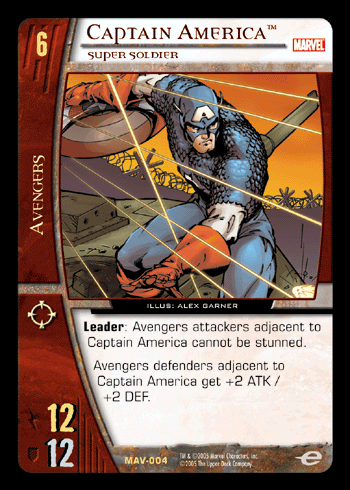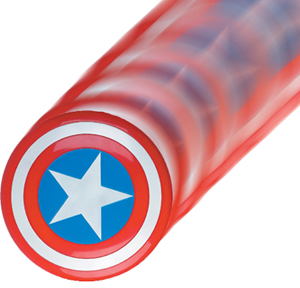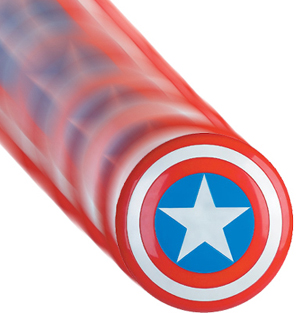We had planned to post this preview tomorrow, but with Comic Con starting today, we decided to celebrate by letting you guys have an exciting peek at The Avengers. Enjoy, and be sure to come to Comic Con if you are in the area!
Toby Wachter
Managing Editor, Metagame.com
This is my favorite time in a new set’s life-cycle: the posting of the first spoiler preview.* It’s the time when anticipation and speculation are at their highpoints—oh, who am I kidding? You’ve already skipped over this intro to look at the card.

Done? OK, good. Let’s start by looking at what the box-topper insert has to say about the “leader” mechanic.
Leader characters have one or more leader powers. These powers reference characters adjacent to the leader. Two characters are adjacent if they are in the same column or side-by-side in the same row.
Pretty simple, right? Everything you need to know about each leader character’s powers is written out on the card. This might beg the question, “Why make ‘leader’ a keyword at all?” Good point. By making “leader” a keyword, we’ve opened up design space so that other cards in the set can interact with the leader characters.
 There’s the simple stuff, like “look for a leader character,” “discard a leader character card,” and “target leader character gets +X ATK.” We can also make cards that give leader powers to non-leader characters, or we can even take leader powers away. Using a keyword also helps players understand how these characters can interact with other characters on the board. When a player sees the leader keyword, he or she will realize that the character has some level of interaction with adjacent characters.
There’s the simple stuff, like “look for a leader character,” “discard a leader character card,” and “target leader character gets +X ATK.” We can also make cards that give leader powers to non-leader characters, or we can even take leader powers away. Using a keyword also helps players understand how these characters can interact with other characters on the board. When a player sees the leader keyword, he or she will realize that the character has some level of interaction with adjacent characters.
The final version of the leader mechanic ended up being somewhat different from my original proposal to the R&D team. The term “leader” was tossed around in design discussions as early as the Spider-Man set, but no mechanics were suggested back then. With the Marvel Knights set, the R&D team started taking a strong look at improving the power, flexibility, and ease of allowing two or more team affiliations to team-up. In that set and in Green Lantern, we incorporated those types of effects into ongoing plot twist cards.
This got me thinking about the potential for team-up effects focusing on characters in play rather than plot twists. The first idea that I pitched for the leader mechanic was that a non-stunned leader character would give all adjacent characters his or her team affiliation. I had intended for the mechanic to facilitate Sealed and Draft play, especially when you had the initiative.
In one of our earliest Avengers design meetings, we talked about the potential problems with the proposed mechanic. The biggest issue was that your leader characters would almost always be stunned early when you didn’t have the initiative, causing your team-up plan to fall apart. In Constructed play, this type of leader power wouldn’t be reliable enough to replace the dependability of an ongoing plot twist.
 Talking about the mechanic some more, Ben Rubin (resident R&D genius) suggested that each leader power could be different. We could tailor individual leader powers to fit the mechanical and thematic goals of each of the different teams. The idea resonated with the group, and that’s how the leader powers appeared in the first design draft.
Talking about the mechanic some more, Ben Rubin (resident R&D genius) suggested that each leader power could be different. We could tailor individual leader powers to fit the mechanical and thematic goals of each of the different teams. The idea resonated with the group, and that’s how the leader powers appeared in the first design draft.
Another issue that came up during initial testing was whether or not we wanted a player to have only one leader power active at a time. From a thematic standpoint, we wondered if it would make the most sense for only one character to be calling the shots for the team. We talked about possible ways to represent this mechanically. We could have made it so you had to KO a leader character in play whenever you played a new one (like the uniqueness rule). We also looked at declaring an active leader power for the turn at the start of a given phase. In addition, we tested the complexity level of allowing multiple leader characters to be in play and the potential for a character to be given two or more leader effects.
Ultimately, we went for the elegance and simplicity of allowing each leader character’s powers to work while in play. Testing revealed that most characters were affected by only one leader character at a time in general. In decks focusing on leader characters, characters would sometimes get the benefit of two or even three leader effects, but that provided its own unique and interesting play patterns.
 The relative value of a leader power can heavily depend on whether an opponent’s characters have flight and whether the leader character has range. Life is good when you have the initiative. When that happens, your focus revolves around creating the best formation to maximize the bonuses provided by your leader characters. When you don’t have the initiative, you might look to put your leader character in the back row. You’re usually hoping that your opponent’s characters don’t have flight for attacking your leader character directly and that your leader character has range for attacking back.
The relative value of a leader power can heavily depend on whether an opponent’s characters have flight and whether the leader character has range. Life is good when you have the initiative. When that happens, your focus revolves around creating the best formation to maximize the bonuses provided by your leader characters. When you don’t have the initiative, you might look to put your leader character in the back row. You’re usually hoping that your opponent’s characters don’t have flight for attacking your leader character directly and that your leader character has range for attacking back.
The good news is that formations are going to be more important in the Avengers set than they are in the Green Lantern set. Sure, there’s a good mix of flight and range among the characters, but characters with flight and range won’t be the norm this time. As the previews continue, you’ll see how formations and adjacency are central themes in the Avengers set.
That brings us to the Super Soldier himself. It would be a crime to debut the leader mechanic without choosing Marvel’s iconic leader as the featured card.
Cap’s leader power does an excellent job representing what the Avengers team is all about in the comics. The Avengers are Earth’s Mightiest Heroes, joined together to fight foes that no single hero could withstand.
Here’s a final fun fact: The Avengers was the first Vs. System set that didn’t have Danny Mandel as a member of the design or development team. As lead designer, I found Danny’s absence to be very unfortunate, because he would have brought me my breakfast burrito in about half the time it took Andrew Yip to. We miss you, Danny.
Be sure to check back tomorrow to find out about another card from the Avengers expansion.
Monday's Preview: